Semantic SEO is a school of thought that encourages content optimisation based on concepts, entities, and the relationships between them, representing a shift away from the traditional keyword-centric approach to SEO.
Search engines have evolved their natural language processing (NLP) capabilities over time. This has enhanced the way they understand the context and nuances of language use – bringing them closer to an appreciation of the true meaning or intent behind the terms that users search. Today, the focus for search engines is on delivering results that match what users are actually searching for, rather than just matching up search terms with keywords in content.
This is the foundation of semantic SEO. Recognising how search engines have evolved, proponents of this approach aim to satisfy search intent completely through each individual piece of content they create, instead of focusing on target keywords at face value. Over time, semantic SEOs look to build interrelated networks of pages that together demonstrate comprehensive topic coverage, mirroring the way in which Google’s Knowledge Graph works.
The ultimate objective is for your site to become recognised for its expertise on a particular set of topics, earning topic authority that helps each individual page to rank higher. With this in mind, it’s clear to see how semantic SEO is very much in keeping with Google’s own Search Quality Rater Guidelines, which place the interconnected concepts of experience, expertise, authority, and trust (E-E-A-T) front and centre.
In this guide, we’ll get into how semantic SEO works, the value it can offer, and how you can start experimenting with this approach to make your website more relevant and visible on search engines. Keep reading for tips and insights from our in-house experts, covering everything you need to know about semantic SEO.
Ready to get started with semantic SEO? Our SEO specialists are well-positioned to help – get in touch today.
- What is semantic SEO?
- Semantic SEO vs traditional SEO
- How semantic SEO has changed the SERP landscape
- Why is semantic SEO important?
- The benefits of semantic SEO
- Improved search engine rankings
- Helps Google to understand and rank your website content better
- Higher keyword coverage
- Enhanced SERP visibility
- Better ranking in AI-driven features
- Improved CTR and engagement with your website
- Semantic SEO: Beyond best practice
- Understand user intent
- Expand your keyword research
- What are semantic keywords?
- Develop topic clusters
- Create a content outline
- Create detailed content
- Answer ‘People Also Ask’ questions
- Implement structured data markup
- Use internal linking to reinforce associations
- Semantic SEO in action
- Best tools for semantic SEO
- 1. Google Autocomplete
- 2. Google Related Searches
- 3. AlsoAsked
- 4. AnswerThePublic
- 5. Ahrefs
- Boost your search visibility with a semantic SEO strategy
What is semantic SEO?
Semantic SEO is the process of optimising content for context and meaning, not just keywords. Previously search engines evaluated pages primarily based on keyword placement. Simply repeating a keyword numerous times throughout your copy could signal to Google that your page was relevant and deserving of a place in the search engine results pages (SERPs). Semantic SEO, however, looks to optimise content based on a deeper understanding of search intent and the relationships between related entities and concepts.
Semantic SEO vs traditional SEO
The main difference between the two is their focus: traditional SEO is keyword-centric, while semantic SEO is context-centric.
Traditional SEO focuses more on optimising pages for specific keywords, whereas semantic SEO places a greater emphasis on understanding the user’s intent behind the search query as well as the demonstration of experience, expertise, authoritativeness and trust (E-E-A-T), which are key concepts in Google’s Search Quality Rater Guidelines.
While keywords are still important, the goal with semantic SEO is to create networks of content — with each page in a network covering its own topic or subtopic in sufficient depth to satisfy search intent completely. Individual pieces of content become like the nodes in Google’s Knowledge Graph; we signal the relationships and associations between them via internal links to form an overall topic map.
In this way, sites can become perceived as expert contributors for their topic area(s), and naturally be viewed as the authority that should be ranked highly for any related keyword. The emphasis on topic authority becomes more important than just focusing on the terms that users might be searching for.
How semantic SEO has changed the SERP landscape
In the early days of SEO, search engines relied heavily on exact-match keywords to determine a page’s relevance. For instance, a page about ‘healthy eating habits’ would need to repeat that phrase multiple times to rank well. However, the introduction of algorithms like Hummingbird in 2013 marked a pivotal change in this approach.
Now, search engines employ sophisticated natural language processing to grasp the broader context of content. This means instead of just identifying keywords in your copy, Google now reviews and understands the topic as a whole.
A well-optimised article on healthy eating might rank for various related queries such as ‘nutritious meal planning’, ‘balanced diet tips’, or ‘foods for wellness’, even if these exact phrases aren’t repeatedly used. This semantic approach has significantly improved the user experience on SERPs, providing more relevant and comprehensive results.
The impact of Hummingbird was profound, as it led to the rise of featured snippets and emphasised the importance of high-quality, comprehensive content that addresses user needs directly. This shift has continued with subsequent updates like RankBrain and BERT, which further enhanced Google’s ability to understand nuanced language, context, and user intent.
As search evolves, AI-driven updates continue to refine this approach. Google’s Search Generative Experience (SGE) and AI Overviews (AIO) build on semantic search principles, prioritising well-structured, informative content that aligns with user intent. This makes it more important than ever to create content that not only includes relevant terms but also fully answers user queries in a meaningful way.
Why is semantic SEO important?
Semantic SEO is important because it aligns your content with what users are searching for and how Google evaluates online content. By focusing on optimising content for both keywords and the overall topic, as well as search intent, your content is more likely to generate traffic and revenue.
The benefits of semantic SEO
We’ve touched on some of the benefits of semantic SEO already. Let’s take a closer look.
Improved search engine rankings
Semantic SEO helps search engines understand the full context of your content. By using structured data and providing clear semantic signals – like related keywords, topic clusters, and natural language patterns – you give search engines more context about the meaning of your content. Semantic signals go beyond individual keywords, focusing on how terms relate to one another and the overall subject. This approach helps your website align more closely with user intent, making it more likely to rank higher in relevant search results, ultimately improving your overall search visibility.
Helps Google to understand and rank your website content better
Google’s mission is to provide users with the most accurate, trustworthy, and useful information. As part of this, it assesses content based on its relevance and context. By keeping your content accurate, updated, and well-rounded, while following Google’s E-E-A-T guidelines, you signal to Google that your page is high-quality – boosting your chances of ranking higher.
Higher keyword coverage
By focusing on the broader context of your topic, semantic SEO enables you to target a wider range of related keywords, including long-tail variations. This helps capture more organic traffic and expands your reach. Moreover, as you create more in-depth content, you naturally have more opportunities for internal linking, which further strengthens your SEO efforts by guiding users through relevant pages and improving overall site navigation.
Enhanced SERP visibility
With structured data, you can create semantic relationships that enhance your search engine results page (SERP) listings. Rich snippets, like star ratings, reviews, pricing, and images, make your listings more informative and visually appealing. Centring your approach around semantic SEO principles can also help your content appear in SERP features like the People Also Ask section, where concise answers to user queries drive more targeted traffic to your website.
Better ranking in AI-driven features
As AI algorithms become more sophisticated, they analyse content semantically, focusing on the overall meaning rather than just specific keywords. With semantic SEO, your content better aligns with AI’s ability to understand nuanced, context-driven questions. Features like AI-powered summaries pull relevant, authoritative information directly from your pages, so structuring your content clearly and with well-researched insights gives you a better chance of being featured.
Improved CTR and engagement with your website
Semantic SEO ensures your content meets user intent by answering questions directly and providing relevant, valuable information. When users find what they’re looking for quickly, they’re more likely to engage with your content, stay on your site longer, and return for more. This ultimately lowers bounce rates and encourages higher user engagement, leading to better conversions.
Semantic SEO: Beyond best practice
While traditional semantic SEO guidelines are a good starting point, real growth comes from challenging the basics. Success lies in going beyond surface-level practices – anticipating user intent, providing deeper context, and creating more meaningful, comprehensive content.
The following strategies move past standard best practices, ensuring that your content doesn’t just rank but truly engages your audience. Here are our advanced strategies for mastering semantic SEO:
Understand user intent
The foundation of Semantic SEO is understanding what users truly want when they enter a search query. Google’s goal is to provide results that fully address a searcher’s intent, not just isolated snippets of information. This means your content should go beyond answering a single question, it should anticipate related needs and provide a comprehensive, valuable resource.
For example, someone searching for ‘how to do SEO’ isn’t just looking for a single-step answer. They may also want to know:
- What are the key steps to building an SEO strategy?
- How do on-page and off-page SEO differ?
- What tools can help with SEO analysis?
- How long does SEO take to show results?
By structuring your content to address these interconnected topics, you create a seamless experience where users can find everything they need in one place. This not only improves engagement but also signals to search engines that your content is authoritative and valuable, increasing the chances of ranking higher.
Understanding search intent is key to creating content that ranks and converts. Read our full guide on using search intent to shape a content strategy.
Expand your keyword research
Semantic SEO isn’t just about optimising for a single keyword; it’s about covering a topic in depth using related terms and concepts. Many content creators focus only on primary keywords that match their products or services, but a stronger approach involves incorporating semantic keywords as well.
What are semantic keywords?
Semantic keywords are words and phrases that are contextually related to your main topic, helping search engines understand meaning and intent. They include synonyms, variations, related questions, and supporting subtopics. For example, if you’re writing about ‘local SEO’, relevant semantic keywords might include:
- local seo best practices
- what is local seo
- local seo strategy
- local seo tips
- local seo tools
In the same way, Google gets that our page about our SEO services includes terms like ‘search engine optimisation’, ‘search optimisation’, ‘search marketing’ and so on. There’s no need for us to create separate pages for each of these variations, as they can all be targeted within one comprehensive piece of content.
Some sources call these Latent Semantic Indexing (LSI) keywords, but Google doesn’t actually use LSI. Instead, it relies on more advanced techniques like the Knowledge Graph, natural language processing (NLP), and AI-driven machine learning to understand context and intent. Rather than simply matching keywords, Google analyses how words relate to each other. That’s why it can tell the difference between ‘Manchester to London’ and ‘London to Manchester’, recognising that while the words are the same, the intent behind each search is different.
To find related semantic keywords, you can use tools designed for keyword research or explore Google-suggested keywords. For example:
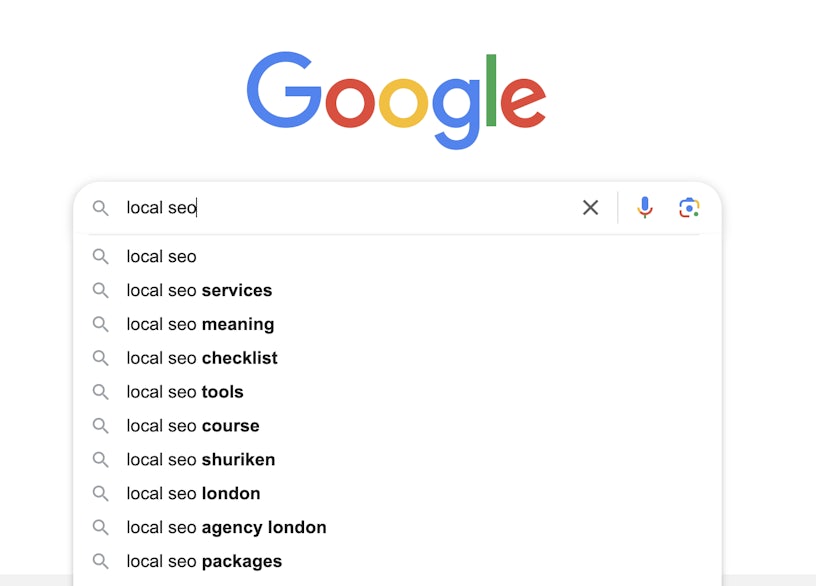
Develop topic clusters
A topic cluster is a structured content strategy that connects multiple related pages around a central theme. At the core is a pillar page, which serves as the main hub, with supporting cluster pages linking to and from it.
For example, at Impression, we’ve applied this approach to our core areas of expertise, such as SEO, PPC, PR, etc. Our pillar pages on these topics provide an overview and serve as hubs, while our cluster pages explore longer tail queries within those topics (such as ‘ecommerce SEO‘, ‘international SEO‘, ‘local SEO’, and so on). These are search terms that people search for with a different intent behind each one, and the pages serve the user’s needs, as opposed to being created for Google.

This approach mirrors how Google’s Knowledge Graph works, where topics are interlinked, creating a network of related information. By structuring your content with clear topic clusters and linking related subtopic pages, you’re helping Google better understand the relationships between your content. This can result in your site achieving better topic coverage and increased visibility, as Google cross-references your content network with the Knowledge Graph, validating your authority in a particular field.
When structuring content this way, we not only show search engines that we are an authority in these areas, but we also create a seamless, user-friendly experience. This helps users find exactly what they need and signals to Google that our content covers the topic comprehensively.
Create a content outline
A topic outline is a key component of Semantic SEO, ensuring that your content is both comprehensive and well-structured. By breaking your main topic into logical sections and subsections, you create a roadmap that enhances readability, improves search relevance, and signals topical authority to search engines.
Your outline should be divided into clear main sections (H2 headings) and detailed subsections (H3 headings). Depending on the depth of the topic, you may also need additional subsections (H4 headings) to cover every aspect thoroughly. This structured approach ensures that your content is well-organised and fully addresses the subject.
For example, if you’re creating a comprehensive guide to local SEO, your outline might start with a broad introduction before expanding into dedicated sections on key aspects such as setting up a Google Business Profile, optimising it for visibility, and implementing advanced local SEO strategies. Each section should be researched as if it were its own standalone article to ensure depth and authority.

At the core of this structure is the main pillar page – your ultimate guide to local SEO. Supporting this are in-depth sections that explore critical elements like the Google Map Pack, ranking factors, and strategic implementation. Each part of the outline plays a role in making the content as informative and useful as possible, ensuring complete coverage of the topic.
By taking this structured approach, you create an authoritative, user-centric resource that not only ranks well in search but also provides real value. It ensures visitors find exactly what they need while reinforcing your content as a go-to reference in your industry.
Create detailed content
Semantic SEO requires us to produce detailed, comprehensive content. This means diving deep into a topic, addressing various aspects and potential questions your audience may have.
While content length isn’t a direct ranking factor, thorough content that covers multiple angles tends to send stronger semantic signals to search engines, indicating the content is highly relevant to user intent.
Rather than relying on keyword stuffing or excessive repetition to lengthen your content, focus on providing meaningful insights. Start by researching top-ranking content for your topic to get a sense of the scope and depth needed. Pay attention to gaps in the coverage that you can fill, ensuring your content offers more value and answers a wider range of questions.
Additionally, tools like AnswerThePublic can help uncover frequently asked questions related to your topic. For instance, searching for ‘local SEO’ might reveal queries such as:

By integrating these questions and addressing them in a well-rounded, detailed manner, you not only improve the user experience but also help search engines understand that your content is authoritative and highly relevant. This can ultimately lead to improved rankings and greater visibility.
Answer ‘People Also Ask’ questions
When searching on Google, you’ve likely seen the People Also Ask section, usually found just below the featured snippet. This section displays questions commonly searched by users related to your topic. Google uses these questions to rank content that directly addresses common queries.
Incorporating these questions into your blog posts not only helps enhance user experience, which is a key part of Semantic SEO but also increases your chances of ranking higher in search results.
Here is an example of the ‘People also ask’ section when searching for ‘what is local SEO’ on Google.
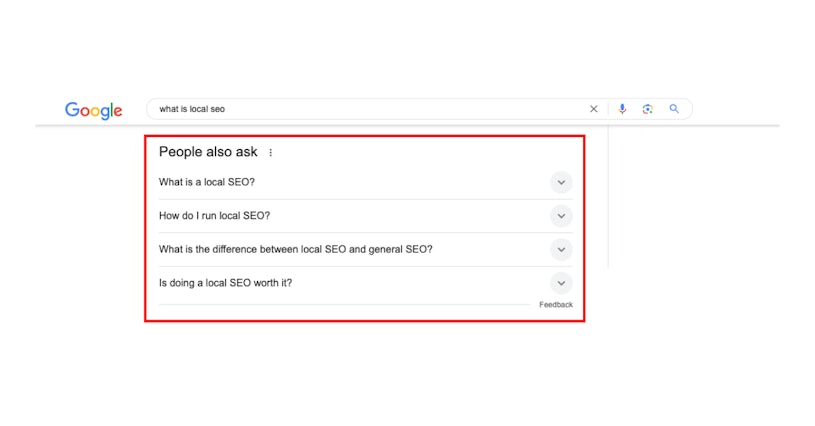
Answering these questions in your content boosts its relevance and provides better value to users, increasing the likelihood of your page being featured in the People Also Ask box.
Implement structured data markup
To help Google better understand and display your content, use structured data, (also known as schema). This markup provides a clear way to classify the information on your page, making it easier for search engines to interpret your content correctly.
Structured data helps highlight key details like the topic, description, images, videos, ratings, reading time, and more. By adding this markup, your content becomes more accessible to both search engines and users, increasing the chances of appearing as rich snippets and enhancing visibility in search results. Here’s an example below:

You can use Schema.org to generate structured data for your content. This framework helps define the meaning of your content and its relationship to other elements on your website. At the very least, structured data ensures search engines can index your pages more accurately.
When combined with high-quality content, structured data can improve visibility and may contribute to higher rankings in organic search results.
Use internal linking to reinforce associations
When practising semantic SEO, it’s crucial to link related content together in a way that reflects your site’s overarching topic clusters. A strategic internal linking approach supports both search visibility and user experience.
When you create new content, make sure to link to other relevant pages on your site. This reinforces the topical relevance of the content and boosts its chances of ranking higher. Additionally, linking your pillar pages to related cluster content signals authority and relevance to search engines, improving their crawlability and ensuring important pages are prioritised.
For example, if your main landing page for a product or service is ranking well, linking to related subpages, like specific product categories or tutorials, can help improve those pages’ rankings as well.
This creates a seamless network of content that not only makes it easier for users to find what they need but also signals to Google that these pages are interconnected.
Semantic SEO in action
Semantic SEO is at the core of how we’ve secured the top position for ‘digital strategy agency’ with our digital strategy services page. This success isn’t just about optimising a single page – it results from a well-structured content strategy that satisfies user intent and reinforces our authority in the topic.
Our digital strategy page is designed to meet the needs of users searching for a strategy-focused agency. It provides clear information on our approach, methodology, and services, ensuring that visitors immediately find what they’re looking for. The page is optimised for relevant queries and structured to enhance engagement, with clear CTAs and supporting content that builds credibility.
Beyond the core service page, a strong network of supporting content strengthens our expertise in digital strategy. Articles like building a marketing plan that actually works, measurement plans and KPI frameworks, and measure marketing effectiveness with media mix modelling demonstrate our expertise in strategy planning and analysis, while others such as why marketing insights are important for your digital strategy and our 3-step approach to competitor analysis support broader aspects of digital strategy. Each of these pieces is internally linked back to our digital strategy page, increasing its relevance and visibility for target queries.
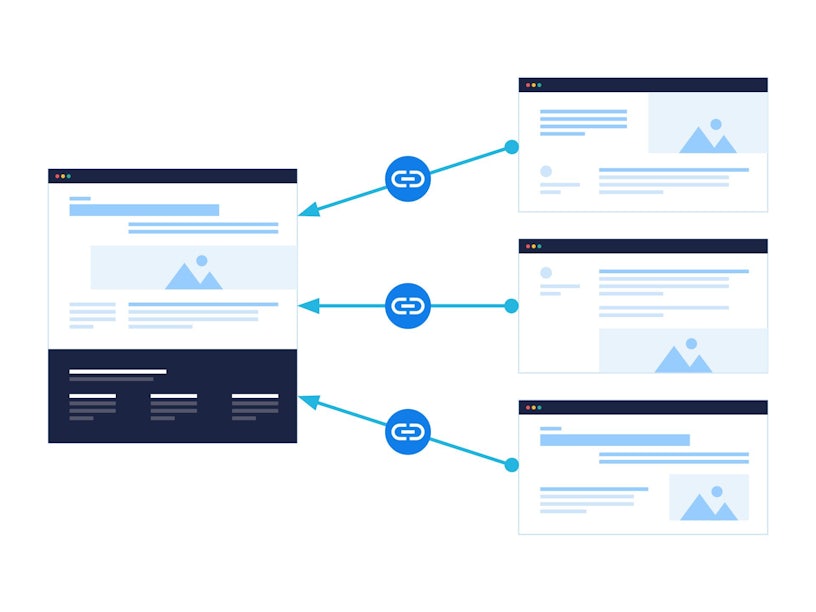
By integrating these articles into a structured internal linking strategy, we reinforce the digital strategy page as the authoritative hub on the topic. This interconnected content approach helps Google recognise our expertise in digital strategy and ensures that users exploring related topics naturally find their way to the core service page.
Best tools for semantic SEO
To create content that ranks well and provides real value, you need the right tools to guide your research and structure your topics effectively.
From Google’s free built-in features to powerful third-party platforms, these tools will help you discover trending topics, uncover search patterns, and build well-structured, authoritative content. Whether you’re working with a limited budget or looking for advanced insights, here are some of the best tools for Semantic SEO.
1. Google Autocomplete
Google Autocomplete suggests search terms as you type into the search bar, based on real user queries. This helps uncover commonly searched variations of your topic, making it a great starting point for semantic SEO and content expansion.

2. Google Related Searches
At the bottom of Google’s search results page, you’ll find Related Searches – a list of suggested terms closely associated with your query. These recommendations reflect user search behaviour and can help you identify relevant subtopics to cover in your content.
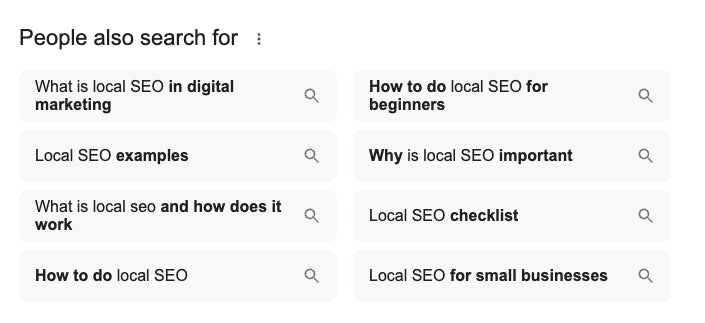
3. AlsoAsked
AlsoAsked extracts and visualises related search queries from Google’s “People Also Ask” section, helping you uncover common user questions and structure your content around search intent. The free version offers a limited number of searches per day, but even with restrictions, it’s one of the best tools for understanding query relationships in a visual format.
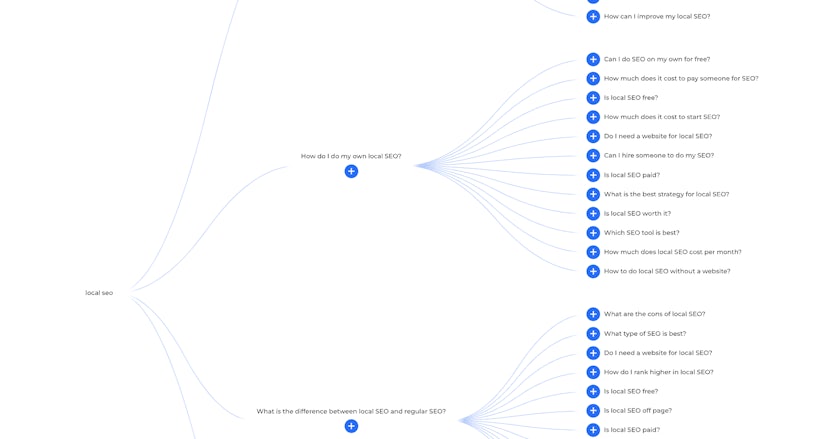
4. AnswerThePublic
Another great tool is AnswerThePublic, which generates content ideas based on real user queries. It provides a wealth of data, including questions people are asking, prepositions, comparisons, alphabeticals, and even related searches. The free version allows up to three searches per day (or just one without signing up), but even with limitations, it’s one of the most powerful tools for discovering semantic keyword opportunities.

5. Ahrefs
While Ahrefs is a paid tool, it’s one of the best platforms for comprehensive SEO research. With just one keyword, you get everything you need – related terms, questions, search intent insights, keyword difficulty, and competitor rankings – all in one place. If you’re serious about SEO, investing in Ahrefs can save time and provide deeper, data-driven insights for content optimisation.

Boost your search visibility with a semantic SEO strategy
Investing in a semantic SEO strategy is one of the most effective steps you can take for long-term success. While traditional keyword research remains essential, semantic keyword research goes beyond it, aiming to demonstrate your domain knowledge within Google’s Knowledge Graph. This approach enhances the scope and depth of your content, delivering more relevant, accurate results for both users and search engines.
If you need help implementing a semantic SEO strategy or boosting your organic visibility to achieve business goals, Speak to our team today or head over to our SEO agency page for a taste of how we can help.






